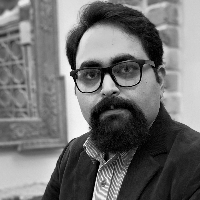Origins and Types of Human Sculptures from 5th to 7th cen. AH of Iran
Coronation of Toghrul Bek in Neyshabur in 429 AH and consolidation of the Seljuks in Iran, led to transformations and developments in arts which are well known as one of the highlights of the art of Iran. Among the pottery works of the Seljuk era, we can mention human figures with different functions and states. In addition to pottery, many gypsum sculptures in various and sometimes large dimensions have been obtained as high-reliefs from various regions, including Ray, which can be called sculptures that are attached to the wall on one side. These figures, only some of which have been mentioned in books and most of which have been placed in museums around the world, have been less studied and unfortunately non-Iranians have written more about these works of Iranian art than Iranian scholars. The present article, with the aim of typology of these human sculptures, intends to introduce these sculptures and to provide a specific classification for their recognition. The research question is that the human sculptures of the Seljuk era can be divided into several groups in terms of use, subject and materials, and what are the characteristics of each group? This article is among the qualitative researches which is done by descriptive-analytical method and gathering information in a field method and using the resources of valid libraries and websites. The statistical population of the present study consists of human sculptures of the Seljuk era, the exact number of which is unfortunately not known, and the samples studied in this article include 25 numbers that have been selected by available means .In the sampling process, only works have been selected that have a specific identity information and have been introduced by museums or scientific books, and their attribution to the Seljuk, Khwarezmian and early Ilkhanate dynasty is evident. It is noteworthy that the initial collected samples were 44, which due to the limitation and impossibility of providing all the samples, it is sufficient to mention the details of 25 samples in the text of the article .As result of the research, it should be said that the first point that appears from the human figures of the Seljuk era was the desire to build the statue in the period known as the revival of the Sunnis; a desire that is not limited to human figures and also shows itself in other examples of the Seljuk era. This tendency towards sculpture, which occurred in the handicrafts and architecture, was not confined to the above-mentioned areas, and eventually led to independent sculpture .As stated in the question and purpose of the research, the present article sought to provide a clear classification of human sculptures of the Seljuk era based on general characteristics (gender and general position) and specific characteristics including usage, subject and materials. In this regard, seven groups of general classification were proposed, including men on horseback, men sitting, men standing, mothers and babies, musicians, court women, and women and men. Standing men, which are in the form of statues, include hunting and military subjects made of glazed pottery. Sitting men are also independent figures, sculpted with the themes of attending "Mazalem" or "Sama", attending a ceremony of rejoicing, a servant, and unspecified subjects with glazed pottery and painted stucco .Among the standing men, there are sculptures of all three uses, painted stucco, stone and glazed pottery with the theme of the guard, the sultan and the warrior man .Mother and babies are merely sculptural vessels representing a mother breastfeeding, made of glazed pottery for use. The musicians (most likely women) are architectural sculptures and sculptural vessels as representations of women playing the harpsichord or "Dayereh" made of glazed pottery and painted stucco .Court women, like musicians, are architectural figures and sculptural vessels that depict a woman sitting or standing in a luxurious gown made of stucco or glazed pottery. The busts can be called the only group that are completely independent and embody the faces of court men and women through glazed pottery and painted stucco. The Eastern (Eastern Turkestan) and Iranian (Parthian and Sasanian) roots are evident in the type of making plaster figures and the painting of ceramic vessels.
- حق عضویت دریافتی صرف حمایت از نشریات عضو و نگهداری، تکمیل و توسعه مگیران میشود.
- پرداخت حق اشتراک و دانلود مقالات اجازه بازنشر آن در سایر رسانههای چاپی و دیجیتال را به کاربر نمیدهد.



